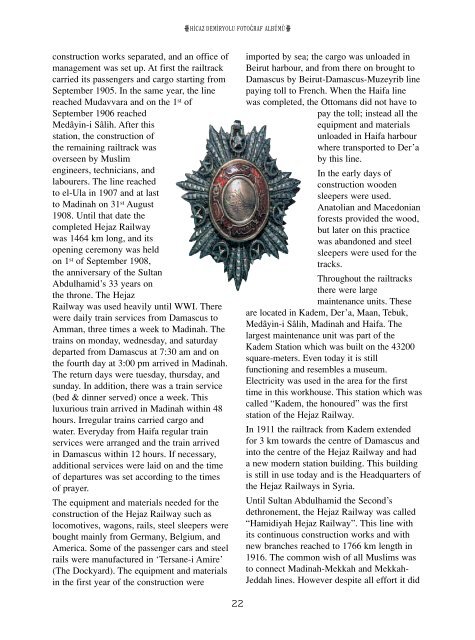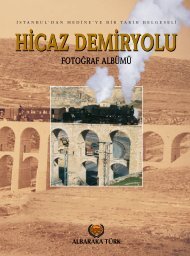Create successful ePaper yourself
Turn your PDF publications into a flip-book with our unique Google optimized e-Paper software.
X H‹CAZ DEM‹RYOLU FOTO⁄RAF ALBÜMÜ C<br />
construction works separated, and an office of<br />
management was set up. At first the railtrack<br />
carried its passengers and cargo starting from<br />
September 1905. In the same year, the line<br />
reached Mudavvara and on the 1 st of<br />
September 1906 reached<br />
Medâyin-i Sâlih. After this<br />
station, the construction of<br />
the remaining railtrack was<br />
overseen by Muslim<br />
engineers, technicians, and<br />
labourers. The line reached<br />
to el-Ula in 1907 and at last<br />
to Madinah on 31 st August<br />
1908. Until that date the<br />
completed Hejaz Railway<br />
was 1464 km long, and its<br />
opening ceremony was held<br />
on 1 st of September 1908,<br />
the anniversary of the Sultan<br />
Abdulhamid’s 33 years on<br />
the throne. The Hejaz<br />
Railway was used heavily until WWI. There<br />
were daily train services from Damascus to<br />
Amman, three times a week to Madinah. The<br />
trains on monday, wednesday, and saturday<br />
departed from Damascus at 7:30 am and on<br />
the fourth day at 3:00 pm arrived in Madinah.<br />
The return days were tuesday, thursday, and<br />
sunday. In addition, there was a train service<br />
(bed & dinner served) once a week. This<br />
luxurious train arrived in Madinah within 48<br />
hours. Irregular trains carried cargo and<br />
water. Everyday from Haifa regular train<br />
services were arranged and the train arrived<br />
in Damascus within 12 hours. If necessary,<br />
additional services were laid on and the time<br />
of departures was set according to the times<br />
of prayer.<br />
The equipment and materials needed for the<br />
construction of the Hejaz Railway such as<br />
locomotives, wagons, rails, steel sleepers were<br />
bought mainly from Germany, Belgium, and<br />
America. Some of the passenger cars and steel<br />
rails were manufactured in ‘Tersane-i Amire’<br />
(The Dockyard). The equipment and materials<br />
in the first year of the construction were<br />
imported by sea; the cargo was unloaded in<br />
Beirut harbour, and from there on brought to<br />
Damascus by Beirut-Damascus-Muzeyrib line<br />
paying toll to French. When the Haifa line<br />
was completed, the Ottomans did not have to<br />
pay the toll; instead all the<br />
equipment and materials<br />
unloaded in Haifa harbour<br />
where transported to Der’a<br />
by this line.<br />
In the early days of<br />
construction wooden<br />
sleepers were used.<br />
Anatolian and Macedonian<br />
forests provided the wood,<br />
but later on this practice<br />
was abandoned and steel<br />
sleepers were used for the<br />
tracks.<br />
Throughout the railtracks<br />
there were large<br />
maintenance units. These<br />
are located in Kadem, Der’a, Maan, Tebuk,<br />
Medâyin-i Sâlih, Madinah and Haifa. The<br />
largest maintenance unit was part of the<br />
Kadem Station which was built on the 43200<br />
square-meters. Even today it is still<br />
functioning and resembles a museum.<br />
Electricity was used in the area for the first<br />
time in this workhouse. This station which was<br />
called “Kadem, the honoured” was the first<br />
station of the Hejaz Railway.<br />
In 1911 the railtrack from Kadem extended<br />
for 3 km towards the centre of Damascus and<br />
into the centre of the Hejaz Railway and had<br />
a new modern station building. This building<br />
is still in use today and is the Headquarters of<br />
the Hejaz Railways in Syria.<br />
Until Sultan Abdulhamid the Second’s<br />
dethronement, the Hejaz Railway was called<br />
“Hamidiyah Hejaz Railway”. This line with<br />
its continuous construction works and with<br />
new branches reached to 1766 km length in<br />
1916. The common wish of all Muslims was<br />
to connect Madinah-Mekkah and Mekkah-<br />
Jeddah lines. However despite all effort it did<br />
22



